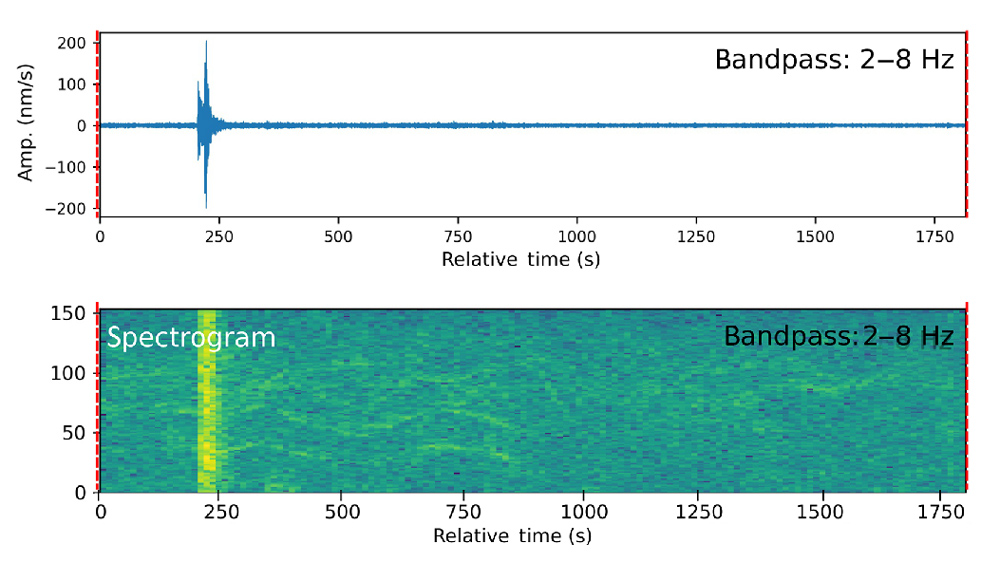Computer scientists and seismologists work to automate the detection of dynamically triggered earthquakes

Computer scientists and seismologists are working together to tackle a big data problem in seismology. Buried in recordings of ground deformation (seismograms) of large, distant earthquakes, one sometimes finds signals, thousands of times smaller, from small, local earthquakes. So, when the ground deformations caused by a distant magnitude 8 earthquake trigger a magnitude 2 earthquake, its signal is imperceptible within that of the large earthquake, even at a station close to the small earthquake. Yet, these small signals carry valuable information about the physics of earthquakes that could help us understand how they begin.
Seismologists Vivian Tang and Kevin Chao processed and examined over a thousand traces of seismograms from eight large earthquakes: One in Chile recorded by many seismic stations from network USArray, in the western hemisphere, and seven in the eastern hemisphere recorded by seismic stations from a temporary network operated by researchers at Oregon State University. Tang found imperceptible, tiny signals from such small earthquakes in about half of these traces.
To better understand how and when such small earthquakes are triggered, more observations are needed, so the seismology team, led by Suzan van der Lee of the Northwestern Department of Earth and Planetary Sciences, looked at ways to automate these detections. One method consisted of calculating a Signal to Noise Ratio (SNR) for the processed data and comparing it to a threshold. This worked but was inconsistent because not all signals are from earthquakes and the method also depends on unrelated noise levels. The seismologists then partnered with computer scientists Prem Seetharaman and Bryan Pardo of Northwestern Engineering to see if Machine Learning (ML) could do a better job at identifying earthquake signals. This computer science team has extensive experience analyzing audio signals, which have technical similarities with seismic signals.
A convolutional neural network seemed promising for the seismology challenge but typically needs much more data to train on than the thousand+ traces labeled by Tang. The computer scientists then applied a deep metric learning algorithm, and rather than training an algorithm to distinguish earthquake signals from non-earthquake signals, they trained the algorithm as to whether a pair of traces belonged to the same class (for example, both contained an earthquake signal) or to different classes. By comparing data series to one another rather than classifying them individually, the amount of data used to train the network is greatly increased from n to half of n-squared pairs, allowing them to learn a robust earthquake detection model from a relatively small amount of training data.
The team tested the trained algorithm in a dozen different scenarios on Tang's clean data set and found that its overall accuracy was always over 90%. This is slightly better than the performance of the SNR algorithm, which fluctuated more wildly. The team then re-introduced traces with more complex signals that had initially been excluded from the study. The SNR algorithm did worse while the ML algorithm retained its robust performance. The results are published in Seismological Research Letters and their approach is open source and available at Github for use by the community.
This robust performance of the ML algorithm is a great outcome, but merely the first promising step in future, more comprehensive studies with more and more diverse data.
Research Paper:
Tang, V., P. Seetharaman, K. Chao, B. A. Pardo, and S. van der Lee (2020). Automating the Detection of Dynamically Triggered Earthquakes via a Deep Metric Learning Algorithm, Seismol. Res. Lett. XX, 1–12, doi:10.1785/0220190165
Mentioned in this article:
- Vivian Tang is a PhD candidate in the Department of Earth and Planetary Sciences and is an IDEAS trainee at Northwestern University. IDEAS is a NSF-funded Research Traineeship program at NU's CIERA.
- Prem Seetharaman is a Postdoctoral Fellow at the McCormick School of Engineering, Northwestern University
- Kevin Chao is a Data Scientist at Biofourmis. He was a Data Science Scholar from 2017-2018 with appointments in the Center for Optimization and Statistical Learning and the Northwestern Institute on Complex Systems (NICO) and a researcher in the Department of Earth and Planetary sciences in academic year 2018-2019.
- Bryan Pardo is a Professor of Computer Science at the McCormick School of Engineering, Northwestern University
- Suzan van der Lee is a NICO Core Faculty member and a Professor in the Department of Earth and Planetary Sciences, Northwestern University
Related Media:

